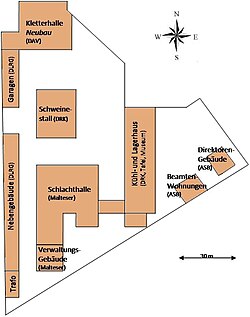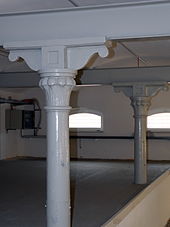Old slaughterhouse (Frankenthal)
| Old slaughterhouse | |
|---|---|
 Entrance to the old slaughterhouse |
|
| Data | |
| place | Frankenthal |
| Architectural style | cubic plastered buildings |
| Construction year | 1880s and 1920s |
 Current floor plan |
|
The former slaughterhouse in the Palatinate town Frankenthal ( Rheinland-Pfalz ) will today officially Center Age slaughterhouse , locally mostly aged slaughterhouse called. Due to its age and size, it is one of the most important building ensembles in the city. The plant operates with its large square-shaped plaster built despite different creation times quite uniform and stands under monument protection .
Geographical location
The ensemble is about 93 m above sea level. NHN northeast outside the historic city center on the north side of Mörscher Strasse, which leads to the district of the same name .
history
Until the end of World War II
The construction of a slaughterhouse in Frankenthal was suggested as early as the 1860s . The city's application to the then competent royal Bavarian government was made on July 24, 1871. However, the building permit was only granted on October 1, 1885.
The slaughterhouse was inaugurated on October 29, 1888 as a municipal facility. On old city maps, however, it can be seen that the first buildings on the site were built on this site as early as the middle of the 19th century. The city's butchers stayed away from the opening ceremony in protest, even though they had all been invited in person. They disliked the new "slaughterhouse and meat sales regulations" that came into force from the opening of the slaughterhouse; This determined, largely for reasons of hygiene, that animals could only be slaughtered in the rooms of the slaughterhouse. Private slaughterhouses in the Frankenthal district were only permitted for horses. A fee was charged for fresh meat brought into Frankenthal from outside.
The task of the slaughterhouse was not only to slaughter the animals intended for human consumption for the city's butchers. The meat examinations required by state law were also carried out here, which was intended to prevent the transmission of diseases from animals to humans and the spread of animal diseases through infectious meat.
After a new administration building had been built around 1900, the site was expanded with an ice-making facility in 1927 and the slaughterhouse facility was significantly expanded and modernized in 1938/39. For example, official apartments were built on the site for city officials employed there. In addition, a slaughterhouse for calves and a new building for pigs were built, the cast iron pillars of which have been preserved to this day. The cold and freezing store, which was also new, had a storage area of 544 m², its floor could be loaded with 1 t / m². The temperature of the cold store was kept between minus 15 and minus 20 ° C all year round.
The new construction and expansion costs amounted to 575,000 RM . Except for a loan of 365,000 RM, which caused a debt service of 20,075 RM, there were no building debts ; because the originally calculated deficit could already be covered in 1939 when the expansion was completed with operating surpluses and a Reich grant. Despite increased expenses as a result of the enlarged operation, the slaughterhouse fees were retained, although they were already among the lowest in the Palatinate and no reserves had been set up until 1937.
As canteen slaughterhouses served the common kitchen of the nearby Feierabendhaus .
The slaughterhouse facility was not only used by the city's butchers, but also served a number of villages in the surrounding area at times. It was designed so large that it could have supplied twice the population with meat without further construction work. During the times of maximum occupancy, up to 14,000 animals were slaughtered each year. The fact that the slaughterhouse was able to keep considerable quantities of meat in stock for the Gau Westmark as an imperial depot turned out to be an advantage , especially during the Second World War . At that time prisoners of war were also employed in the slaughterhouse. The site was largely spared from war damage, even during the devastating bombing of Frankenthal on September 23, 1943, when 90% of the city center was destroyed.
After the Second World War
In March 1950, pending investments were postponed. Because many butcheries no longer slaughtered in the slaughterhouse but at their location, the number of cattle slaughtered had declined. In August 1949, 134 cattle had been processed, but in January and February 1950 the slaughterhouse only had a monthly average of 70. The beef price, which was high for the time, may also have contributed to this development. To compensate for the decline, an average of 35 to 40 horses were slaughtered over a period of months.
On October 9, 1960, the city's residents were invited to an open house. This year the slaughterhouse had a budget of around DM 300,000. The average monthly slaughter was 1,000 pigs, 130 large cattle and 60 calves. Despite the decline, further investments were made in 1960: the slaughterhouses were equipped with a defogger and air conditioning system, the old hot water preparation system was replaced with a new one and a transformer house was built to convert from 110 to 220 V. In January 1962, a Münsterländer Herdbuch cow with a record weight of 1010 kg, which a butcher from Mannheim acquired at the slaughterhouse in Frankenthal, made headlines in the press .
As early as August 1965 it was announced that the slaughterhouse would be closed in 1973. The reasons were youth problems , the reduction of the equalization levy due from 1973 and the increasing personnel expenses due to the so-called dead dispatch . This is how expert circles described the fact that butcher shops were reducing their own staff and the slaughterhouses had animals that had already been cut up as required. The Rhineland-Palatinate Ministry of Agriculture recommended closing the slaughterhouse in Frankenthal. The activities and the staff should be taken over by the slaughterhouse in Ludwigshafen am Rhein . The butchers in Frankenthal resisted, because they feared that their goods would no longer arrive as fresh as before and that there would be capacity difficulties in the already almost fully used slaughterhouse in Ludwigshafen. However, the protests remained in vain.
After the butchers moved out in December 1972, the municipal operations office and the volunteer fire brigade used the site. During this phase, some buildings were modified and partially rebuilt.
Todays use
In the summer of 2001 the city council decided to prepare the area for the Frankenthal disaster control and rescue service associations. With grants from the state government amounting to € 3.5 million, almost all of the former slaughterhouse buildings were renovated in the following years, while some garages and a small outbuilding were demolished.
First the ASB moved into the former director's building. After that, the DAV was settled on the site in a newly built climbing center. The former administration building and the slaughterhouse have been the accommodation of the Maltese since April 2007 . In May 2007, the DLRG moved into the restored cattle barn with a usable area of 400 m², the DRK uses the 370 m² former pigsty, which previously had garages for the municipal depot. Finally, the Frankenthaler Tafel moved in , which was housed in the former office and storage rooms of the cold store, where the Erkenbert Museum also has a warehouse.
Since the completion of this conversion project , the site is now officially called the Alter Schlachthof Center . The term has not yet established itself in common parlance.
gallery
Web links
Individual evidence
- ↑ a b Die Rheinpfalz , local edition Frankenthaler Zeitung, March 12, 2009.
- ^ General Directorate for Cultural Heritage Rhineland-Palatinate (ed.): Informational directory of cultural monuments - district-free city of Frankenthal. Mainz 2020, p. 6 (PDF; 4.2 MB).
- ↑ Map service of the landscape information system of the Rhineland-Palatinate nature conservation administration (LANIS map) ( notes )
- ^ Die Rheinpfalz, local edition Frankenthaler Zeitung, July 7, 2008.
- ^ Frankenthaler Zeitung, October 30, 1888.
- ↑ Die Rheinpfalz, local edition Frankenthaler Zeitung, January 22, 1962.
- ↑ Page no longer available , search in web archives: Palatinate skin utilization: 75 years in the service of butchers , Ludwigshafen 2000.
- ^ The Rheinpfalz, local edition Frankenthaler Zeitung, August 5, 1965.
- ↑ Information board on the site (during construction work).
- ^ Die Rheinpfalz, local edition Frankenthaler Zeitung, January 22, 2007.
- ↑ Frankenthal weekly newspaper, January 24, 2007.
Coordinates: 49 ° 32 ′ 28 " N , 8 ° 21 ′ 41" E





